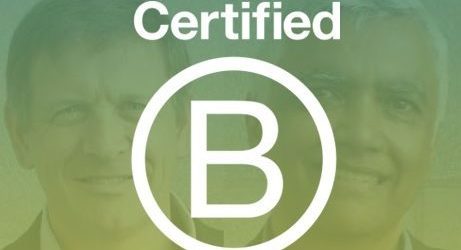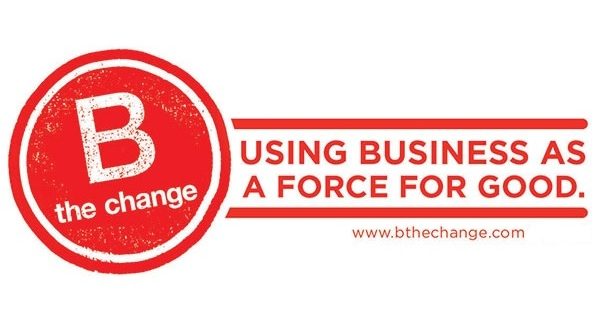Section 1: Overview
View section summary, discussion prompts, activities and resources and more for Section 1: Overview of The B Corp Handbook Instructor's Guide.
Summary
Approximately 25 minutes reading time
Section 1 provides a brief history of the B Corp movement, a description of what B Corps are and why they are important, an overview of an emergent concept called the B Economy, a discussion about what investors think about B Corps, and an analysis of the challenges of the B Corp model for multinationals and publicly traded companies.
The Search for “What’s Next?” (page 23)
B Lab is a nonprofit organization that serves a global movement of people using business as a force for good. It was founded by AND 1’s cofounders, Jay Coen Gilbert and Bart Houlahan, along with Andrew Kassoy, their longtime friend and former Wall Street private equity investor. Coen Gilbert’s and Houlahan’s experiences at AND 1, and Kassoy’s experience on Wall Street, were central to their decision to start B Lab. The three founders wanted to do the most good for as many people as possible. They discovered there was a need for a comprehensive set of performance and legal requirements and started certifying businesses as B Corporations in 2007.
B Corps: A Quick Overview (page 25)
Certified B Corporations must meet three basic requirements: verified social and environmental performance, legal accountability, and public transparency. B Corp certification evaluates an entire company and its practices (such as worker engagement, community involvement, environmental footprint, governance structure, and customer relationships) rather than looking at just one aspect of a company (such as the building or a product). Today, there is a growing global community of thousands of Certified B Corporations across hundreds of industries. To finalize the B Corp certification process, prospective companies must sign the B Corp Declaration of Interdependence, sign a B Corp Agreement, and pay an annual certification fee. The certification term for B Corps is three years, after which companies must recertify to remain a certified B Corp.
The Emergence of the B Economy (page 28)
The emerging B Economy includes not just the certified 2,700+ B Corps but also companies incorporating as a benefit corporation and the 70,000+ companies using the B Impact Assessment or B Analytics to identify areas for improvement. It also includes companies acquiring B Corps subsidiaries as well as consumers, investors, academics and other stakeholders engaged in the broader “business as a force for good” movement. Nonprofits are not eligible for the certification, but any organization can use the B Impact Assessment to measure, manage and improve their impact.
What Do Investors Think about B Corps? (page 28)
The Handbook explores the effect of becoming a Certified B Corporation and/or a benefit corporation on a company’s ability to raise capital. Increasingly, B Corps are appealing to investors because the companies that produce more stakeholder value also produce better financial returns. B Lab research shows that 120 venture capital firms have invested over $2 billion in Certified B Corporations and benefit corporations, including mainstream venture capitalists.
Does B Corp Work for Multinationals and Publicly Traded Companies? (page 29)
Large companies, including multinationals and publicly traded companies, have many opportunities to take part in the growing B Economy. Some of these pathways include becoming a Certified B Corporation, incorporating as a benefit corporation, helping promote the movement to others, and using the B Impact Assessment and/or B Analytics to encourage key stakeholders to improve their social and environmental performance. Another path to getting involved with the B Economy is to acquire a B Corp subsidiary.
Discussion Prompts
- Describe the origins of the B Corp movement.
- How is B Corp Certification different from other eco or “green” certifications and reporting mechanisms such as GRI reporting?
- Where do B Corps fit in the larger sustainable business movement including Conscious capitalism, Sustainability Accounting Standards Board and others?
- Do you agree with the value proposition for investing in B Corps? Why or why not?
- Compare and contrast B Corp certification and benefit corporation incorporation.
- Do you agree with B Lab’s decision to only allow for profit business to certify, excluding nonprofits? Why or why not?
- Should B Lab allow companies in the oil and gas, cigarette, prison industries to become B Corp certified, even if they meet the certification standards? How about companies that sell beer, wine and spirits?
“This guide is a much-needed resource for maximizing the unparalleled learning opportunities in what it can be considered the bible of B Corps. This guide helps instructors bridge the theory to practice gap with a wealth of examples and abundant resources to incorporate B Corp teaching and engagement in our classrooms” — Maria Ballesteros-Sola, Assistant Professor, MVS School of Business & Economics, California State University Channel Islands
Go Further…
Case Discussions
B Lab, “B Lab: Can it scale business as a force for good?”, Christoper Marquis, Matthew Lee, 6/15/2015
B Lab, “B Lab: Building a New Sector of the Economy”, Christoper Marquis, Andrew Klaber, Bobbi Thomason, September 9,2010; Revision Date: September 28, 2011
EcoLibrium Profile
ECO2LIBRIUM (ECO2) is a private company with operations in the Kakamega region of Western Kenya, Africa. After reading the interview in the Handbook, develop a one-page executive summary for EcoLibrium and outline the value proposition for companies in emerging markets like Kenya to pursue B Corp certification.
EcoLibrium B Impact Assessment
- Individual assignment outside of class
- 1 hour
Word Cloud
Create a word cloud from five of the articles listed below. Identify and interpret any trends, specifically regarding diversity, equity, and inclusion (DEI) that you find.
- Individual assignment outside of class
- 2 – 3 hours
Investor Pitch
After reviewing the list of investors and B Corps on page 29, pick one of the B Corps features and develop a pitch for the corresponding investment fund based on researching both parties.
- Research outside of class and 60 second pitch in class
- Teams of 2 – 3 students
- 3 – 4 hours
UNSDGs
Introduce and define the UNSDGs; generate a chart that lists each of the 17 UNSDGs and generate a list of 5-10 (or as many as you can) initiatives that companies can implement that would be consistent with the B Corp Mission and identify the specific UNSDG(s) that they drive progress towards.
- In class project
- 30 minutes
B Corp Interview
Explore the B Corp Directory to find certified B Corps in your area. Select one company to conduct a brief 30 minute interview. Questions might include: Why did you decide to become a certified B Corp? What were some of the challenges associated with obtaining the certification? Who would you identify as your stakeholders? How have your stakeholders responded? Are you planning to re-certify? Why or why not?
Write up a brief profile of the company.
- Individual or projects outside of class
- 2 – 3 hours
Featured Resources
Resources
Articles
The Meaning of Social Innovation, Duke Innovation & Entrepreneurship, J. Gregory Dees, May 30, 2001.
- Explores current theories of entrepreneurship and some of the key defining characteristics of social entrepreneurs.
Why Companies Are Becoming B Corporations Harvard Business Review, Suntae Kim, Matthew J. Karlesky, Christopher G. Myers, Todd Schifeling, June 17, 2016.
- Describes brief structure and history of B Corps and the ways company leaders can use B Corps to accelerate change while maximizing profit.
Business-Building Lessons From The Largest B Corp In The World Forbes, Simon Mainwaring, September 28, 2018.
- A detailed look into certain characteristics of B Corps that all companies should consider.
The Value of B Corps: What Investors Need to Know, Yale Center for Business and the Environment, Heather Fitzgerald, March 13, 2018.
- Discusses why investors do and should care about companies practicing sustainability and how this can increase profits.
Just Good Business: An Investor’s Guide to B Corps, by the Yale Center for Business and the Environment, Patagonia, Inc., and Caprock.
- Defines the investor landscape and explores the value to investors of certified B Corps and benefit corporations.
A Legislative Guide to Benefit Corporations, by Patagonia, Inc., Vermont Law School, and The Yale Environmental Law Association.
- Explores the benefits of incorporating as a benefit corporation, economic impacts of passing benefit legislation and the difference between benefit corps and other corporate forms.
An Entrepreneur’s Guide to Certified B Corporations and Benefit Corporations, Yale Center for Business and the Environment and Patagonia, Inc.
- This guide helps entrepreneurs navigate whether going “B” is a good fit for their business and how to go about securing the designation.
Should your startup take the public benefit or B corp route? Tech Crunch, Mick Bain, 2017.
- Explains some misconceptions of B Corps including why using CSR practices does not mean sacrificing profits.
Videos
B Corp YouTube Channel (various lengths, 1 min to 60 mins), The Official YouTube Channel of B Corporations, companies using the power of business as a force for good.
B Corp 2007-2017, October 3, 2017 (2:35 mins), The driving force behind B Corp and using business as a force for good, why we must more towards an inclusive economy, and statistics of the impact made thus far.
B Corp Anthem 2018, April 16, 2018 (1:56 mins), The reasons why businesses are joining the B Corp movement and why investors and consumers should care.
B Corporation – Vote Everyday Campaign Video, November 11, 2018 (50 sec), “When you buy from, work for and do business with Certified B Corporations, you vote for what you believe in.”
TED talk with B Lab co-founder Jay Coen Gilbert, December 1, 2010 (20 mins), “Jay Coen Gilbert shares his vision to harness the power of business to solve society’s problems through B Corporations — a new standard labeling socially and environmentally responsible companies.”
B Corporation Founders Video, September 18, 2008 (5 mins), Passionate stories and testimonies from the founders and employees of B Corporation.
Podcasts
Next Economy Now Podcast, Ep. 75: Raising the Bar: Native-American-Owned B Corp Tanka Bar Restores Land, Lives, Livelihoods, and Cultures, (37:45, Aug 15, 2017). Erin Axelrod, a LIFT Economy Partner, speaks with CEO Karlene Hunter and President Mark Tilsen of Native American Natural Foods and discusses how a Lakota “give-away” celebration launched Tanka Bar into a national company, the creativity and resiliency of the Lakota people, despite their current status among the top 3 poorest counties in the U.S., as well as the ecological benefits of buffalo on the land how prairies are one of the largest carbon sinks in the world.
Next Economy Now Podcast, Ep. 111: Lisa Curtis: Nutrition, Livelihood, and Environmental Restoration Through Moringa, (48:08, May 29, 2018). Andrew Baskin from the LIFT Economy speaks with Lisa Curtis, founder of Kuli Kuli, which manufactures moringa-based food products that not only aid people with incorporating more vegetables/greens into their diets, but also empowers women-led farming co-operatives all over the world to drive economic growth, women’s empowerment, and sustainable agricultural development.
Next Economy Now Podcast, Ep. 151: Amelia Swan Baxter: Building The Next Economy with WholeTrees, (39:43, Mar 29, 2019). Co-founder of WholeTrees, Amelia Swan Baxter speaks with Erin Axelrod from the LIFT Economy and discusses how WholeTrees provides an ecological, economic, social, and aesthetic benefit. Amelia also describes how the character and inner work of company leaders can ripple throughout an entire organization.
Next Economy Now Podcast, Ep. 141: Brock Dolman: Thirsty for a Balanced Water Budget, (47:02, Dec 25, 2018). Brock Dolman, co-director of the WATER Institute, Permaculture Design Program and Wildlands Program, speaks with Kevin Bayuk about ecological, biological, and economic importance of water, how we should go about maximizing/stretching out water budgets at various scales, and provides suggestions for transitioning ecologically from viscous cycles to virtuous cycles and personal resilience strategies
What Works with Tara McMullin: EP 132: Choosing The B Corp Life with Buzz Food Truck Founder Michael Sirianni (43 Minutes), “Today on What Works, we welcome Michael Sirianni, owner of Buzz, a mobile rock-and-roll inspired sandwich shop serving the Lancaster, Pennsylvania community. But Buzz is about so much more than egg and cheese sandwiches: as a B Corp certified business, Michael runs his restaurant-on-wheels a bit differently than most.”
That Supplement Show: EP 15: What’s It Mean to Be a B Corp?, May 7, 2018 (29 min), “Chances are good that you’ve encountered the “circle B” seal before… but, do you know what it stands for? Learn why businesses are lining up for a chance to B the Change, and understand just what it means when you choose goods and services boasting that capital B.”
How I Built This Podcast, Warby Parker (former B Corp), February 19, 2018 (32:52), Guy Raz explores stories behind some of the world’s best known companies.
How I Build This Podcast, Stonyfield Farm, October 2, 2017 (1:01:15), Guy Raz explores stories behind some of the world’s best known companies.
Section 2: Benefits of Becoming a B Corp


